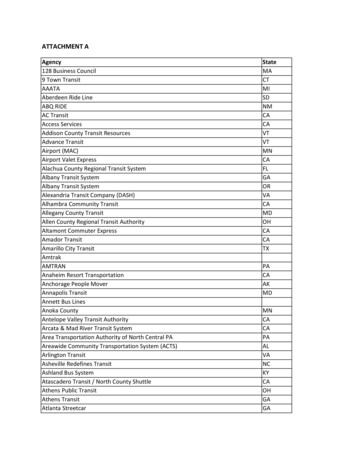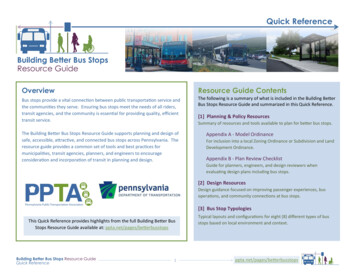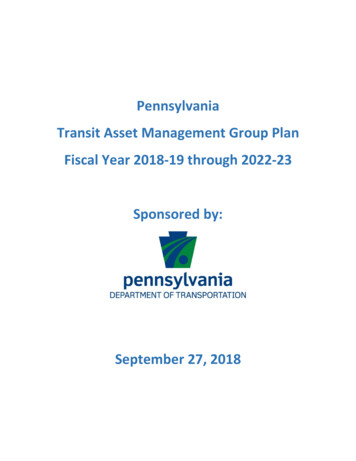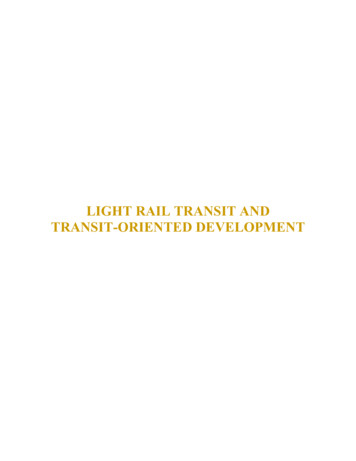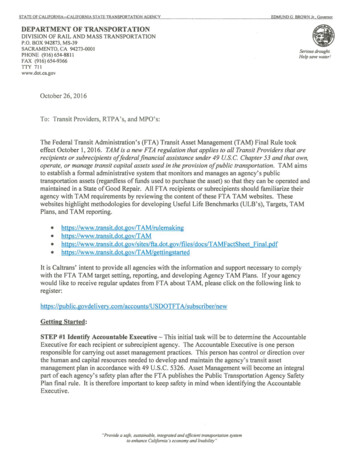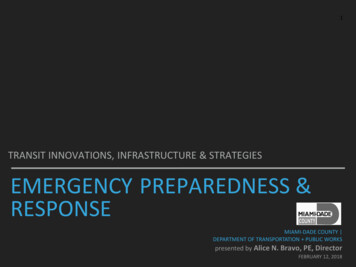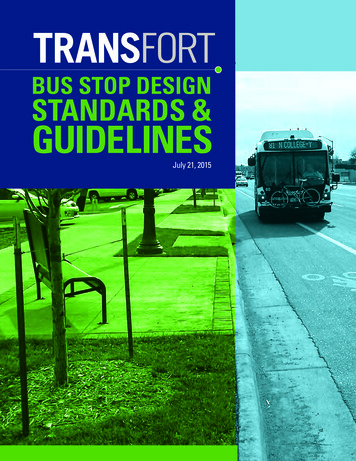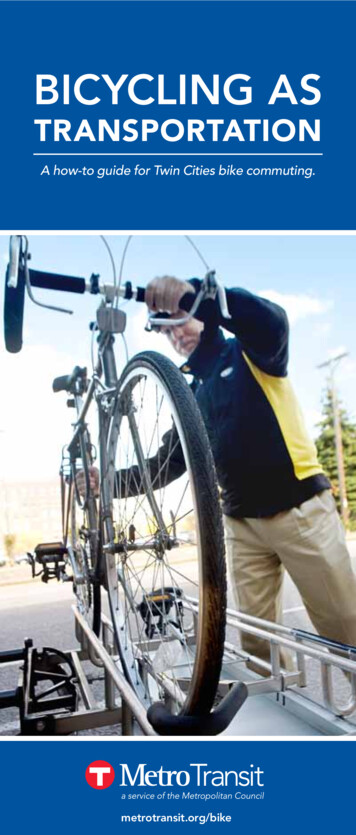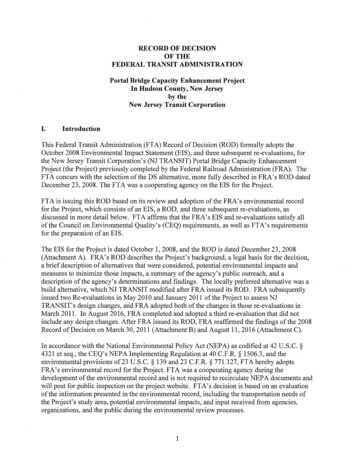
Transcription
RECORD OF DECISIONOF THEFEDERAL TRANSIT ADMINISTRATIONPortal Bridge Capacity Enhancement ProjectIn Hudson County, New Jerseyby theNew Jersey Transit CorporationI.IntroductionThis Federal Transit Administration (FTA) Record of Decision (ROD) formally adopts theOctober 2008 Environmental Impact Statement (EIS), and three subsequent re-evaluations, forthe New Jersey Transit Corporation's (NJ TRANSIT) Portal Bridge Capacity EnhancementProject (the Project) previously completed by the Federal Railroad Administration (FRA). TheFTA concurs with the selection of the DS alternative, more fully described in FRA's ROD datedDecember 23, 2008. The FTA was a cooperating agency on the EIS for the Project.FTA is issuing this ROD based on its review and adoption of the FRA's environmental recordfor the Project, which consists of an EIS, a ROD, and three subsequent re-evaluations, asdiscussed in more detail below. FTA affirms that the FRA's EIS and re-evaluations satisfy allof the Council on Environmental Quality's (CEQ) requirements, as well as FTA's requirementsfor the preparation of an EIS.The EIS for the Project is dated October 1, 2008, and the ROD is dated December 23, 2008(Attachment A). FRA's ROD describes the Project's background, a legal basis for the decision,a brief description of alternatives that were considered, potential environmental impacts andmeasures to minimize those impacts, a summary of the agency's public outreach, and adescription of the agency's determinations and findings. The locally preferred alternative was abuild alternative, which NJ TRANSIT modified after FRA issued its ROD. FRA subsequentlyissued two Re-evaluations in May 2010 and January 2011 of the Project to assess NJTRANSIT' s design changes, and FRA adopted both of the changes in those re-evaluations inMarch 2011. In August 2016, FRA completed and adopted a third re-evaluation that did notinclude any design changes. After FRA issued its ROD, FRA reaffirmed the findings of the 2008Record of Decision on March 30, 2011 (Attachment B) and August 11, 2016 (Attachment C).In accordance with the National Environmental Policy Act (NEPA) as codified at 42 U.S.C. §4321 et seq., the CEQ's NEPA Implementing Regulation at 40 C.F.R. § 1506.3, and theenvironmental provisions of23 U.S.C. § 139 and 23 C.F.R. § 771.127, FTA hereby adoptsFRA' s environmental record for the Project. FTA was a cooperating agency during thedevelopment of the environmental record and is not required to recirculate NEPA documents andwill post for public inspection on the project website. FTA's decision is based on an evaluationof the information presented in the environmental record, including the transportation needs ofthe Project's study area, potential environmental impacts, and input received from agencies,organizations, and the public during the environmental review processes.1
II.Purpose and NeedThe existing Portal Bridge, owned by the National Railroad Passenger Corporation (Amtrak), isa two-track moveable swing-span bridge between the Town of Kearny and the Town of Secaucusin Hudson County, New Jersey. It was constructed by the Pennsylvania Railroad in 1907 andbegan revenue operations in 1910. Both Amtrak and NJ TRANSIT operate trains over the bridgethat serve over 200,000 weekday passenger trips. The existing Portal Bridge poses reliabilityconcerns, capacity constraints, and operational inflexibility. The swing span and the miter railconfiguration pose maintenance difficulties and the bridge's low vertical clearance results insevere conflicts with maritime uses.The purpose of the Project is to replace the 100-year old Portal Bridge and eliminate capacityconstraints on the Northeast Corridor between Swift Interlocking and the Secaucus TransferStation.III.Project AlternativesConsistent with the Project's purpose and need, the Portal Bridge Capacity Enhancement Projectis being proposed to enhance the capacity and improve the operation of the Portal Bridge, apassenger rail bridge which crosses the Hackensack River.Alternatives ConsideredFRA identified and evaluated four build alternatives and a "No Build Alternative" in the FinalEIS. The four build alternatives differed primarily in two respects: (1) the location of thesouthern bridge (either on the alignment of the existing Portal Bridge or on a new southernalignment) and (2) the type of grade-separated crossing for Track 5 (either a duck-under or a fly over design). The four alternatives were as follows. Alternative DS (the Preferred Alternative and environmentally preferred alternativeidentified in the FEIS): This alternative would include a three-track fixed northernbridge, a two-track moveable southern bridge built on a new southern alignment, anda duck-under structure for Track 5. Alternative DE: This alternative would include a three-track fixed northern bridge, atwo-track moveable southern bridge built on the existing alignment, and a duck-understructure for Track 5. Alternative FE: This alternative would include a three-track fixed northern bridge, atwo-track moveable southern bridge built on the existing alignment, and a fly-overstructure for Track 5. Alternative FS: This alternative would include a three-track fixed northern bridge, atwo-track moveable southern bridge built on a new southern alignment, and a fly-overstructure for Track 5.2
Figure 1 below shows the track layout for each of the four build alternatives.Preferred AlternativeFRA adopted Alternative DS, the preferred alternative, in its ROD. This alternative includes theconstruction of a three-track fixed northern bridge at a height of 50 feet above mean high-waterand related approach structures, a two-track moveable southern bridge at a height of 40 feetabove mean high-water and related approach structures built on a new southern alignment, and aduck-under structure for Track 5. The alternative also includes the decommissioning andremoval of the existing Portal Bridge; a new track configuration between Swift Interlocking andSecaucus Transfer Station, including a grade-separated crossing of the Northeast Corridor; newancillary equipment such as signal and communication systems, traction power supply anddistribution systems, and catenary and communication support structures; and new bridges overthe Newark Turnpike, the former Erie Newark-Paterson Branch right-of-way, the BellevilleTurnpike, the former Erie Arlington Branch right-of-way, and the Boonton Line.Design Changes to the Preferred AlternativeSince 2008, NJ TRANSIT and Amtrak have completed preliminary and final engineering andsecured multiple environmental permits for the Project. As the design process evolved, severalaspects of the design were modified and improved. These design changes were analyzed todetermine whether the FEIS should be supplemented through three re-evaluations in 2010, 2011,and 2016. As noted in the Section IV, the design changes reduced the environmental impact ofthe Project. The design changes are as follows with the year of the design change noted inparentheses: The movable southern bridge was changed to a fixed bridge and a network tied archdesign (2010).The approach structures for the northern and southern bridges were changed fromprimarily embankment fill to entirely elevated structures, which reduced propertyimpacts (2010).Design refinements were made to replace certain embankment with a retaining walland elevated structures to reduce property impacts (2010).The northern bridge was modified from a three-track bridge to a two-track fixedbridge (2011 ).NJ TRANSIT would construct the Project in phases, with the northern bridgeconstructed first (2011).Documented advancements in permitting and agency coordination were made (2016).Other design refinements were made to reduce contaminated materials' impacts(2011).3
Figure 1: Proposed Track Configurations for the Four Build Alternatives Analyzed in the EISDuck-Under Option.N \// .\/-------- \-) I!; fli ,tSlahonToNewark:Penns ta I 1 \ :-· / I\/?Soutnern Bridge·To New York·southern brtdge is shown on existing alignment. In alternatives where thesouthern Bridge is built off-alignment it would be located farther to the southOOMO ··-----------Swilt InterlockingNOTTO SCALE4
Table 1 below presents a summary of the design milestones and chronology of NEPAdocuments. FTA reviewed the documents and had no comments.FEISOctober1, 2008ConceptualEngineering ( 10%Design Level)RODDecember23,2008NEPA ReEvaluationMarch 30, Preliminary2011EngineeringComplete (30%Design Level) NEPA ReEvaluationNEPA ReEvaluationMarch 30, Preliminary2011EngineeringComplete (30%Design Level) andBegan FinalEngineering(North BridgeOnly) August11,2016North Bridge FinalEngineeringComplete (June2013) (100%Design Level) South BridgePreliminaryEngineeringComplete (30%Design Level) 53-track fixed north bridge2-track moveable south bridgeApproach structures primarily withembankment fillAcquisition of active businessSouth bridge changed from a movablebridge to a fixed bridge and networktied arch designApproach structures for north and southbridges were changed from primarilyembankment fill to entirely elevatedstructures, reducing property impactsOther design refinements to replaceembankment with retaining wall andelevated structures to reduce propertyimpactsNorth bridge modified from 3-track to2-track fixed bridgePhased construction, with north bridgeconstructed firstDocumented advancements inpermitting and agency coordinationOther design refinements to reducecontaminated materials' impactsDesign advancements included allheavy civil infrastructure elements; allrailroad systems elements;constructability and impact reductions;and safety, security, and technologicaladvancementsCoordinated with all railroad and localpolice, along with host community fireand Emergency Management ServicesAdvanced permitting to completion withU.S. Army Corps of Engineers, U.S.Coast Guard, New Jersey Department ofEnvironmental Protection, and otheragencies
IV. Summary of ImpactsThe Project will have no adverse impacts to the following categories: Land Use and Economics,Socioeconomics and Community Character, Environmental Justice, Air Quality, Public Services,Energy, and Tribal Lands or Interests. The Project would have transportation benefits byimproving the capacity and reliability of the Northeast Corridor through replacement of theexisting Portal Bridge and improving maritime transportation by replacement of the low PortalBridge with a high fixed bridge. The following sections identify specific impacts of the Project.Acquisitions, Displacements, and RelocationsMultiple properties, primarily industrial and transportation related, may be fully or partiallyacquired for the construction of the replacement bridges. The design changes approved in 2011reduced the number of necessary acquisitions by changing the design from utilizingembankments to retaining walls. Additionally, the full taking of the Diamond Shamrock propertywas replaced with aerial easements by modifying the design to an aerial structure.Visual Resources and AestheticsThe Project would not substantially affect the visual character of the study area nor blockimportant views to and from visual resources. The design change of the southern bridge from amovable bridge to a higher-level fixed structure, which was approved in 2011, improves thevisual congruity by having the southern bridge mirror the northern bridge.Noise and VibrationPortions of Laurel Hill Park expansion parcel will be subject to severe noise impacts due to theproximity to the Northeast Corridor. Additionally, the design change from embankment to aerialstructure in 2011 will result in greater short-term noise levels near the Janatex and DiamondShamrock properties due to the use of driving piles at specific pier locations. However, there areno sensitive receptors in the vicinity of this construction and ambient noise levels are alreadyelevated due to the existing presence of the Northeast Corridor.Ecosystems (Vegetation and Wildlife)The Project is expected to fill approximately 6.5 acres of wetlands and open water, but also is notexpected to have long-term adverse impacts to water quality or stormwater. The redesign of theproject reduced the impacted filled area to 4.9 acres, resulting in a reduction of 1.6 acres of theimpacted area. Permits from the U.S. Army Corps of Engineers and the New Jersey Departmentof Environmental Protection committed NJ TRANSIT to the construction work windows andmitigation measures conceptually described in the FEIS and ROD.Water ResourcesThe Project will require construction to occur within a 100-year flood plain; however, the projectwould not result in any long-term adverse impacts to water quality or stormwater in the studyarea or alter the flow of the Hackensack River. Additionally, the design change fromembankment to viaduct structure would reduce the amount of fill that would be placed within theflood plain. There are no operational impacts to water resources.6
Hazardous Materials and WastesThe Project will entail subsurface disturbance in areas with a known degree of contaminationsuch as chromite ore processing residue, in sites such as the Diamond Shamrock property.Construction of the Project will include appropriate health, safety, and investigative/remedialmeasures taken in consultation with appropriate agencies to prevent exposure pathways. Theproposed design changes reduced the amount of disturbance to contaminated soils. Since 2008,the Diamond Shamrock and Janatex properties have been undergoing remediation by theproperty owners.Historic Cultural and Archaeological ResourcesThe Project will involve modification to an area sensitive for human remains and funeraryarchaeological artifacts related to the Historic Cemeteries of Hudson County. The Project wouldalso have an adverse impact to the existing historic Portal Bridge (i.e., removal of the bridge).Mitigation measures are included in a Memorandum of Agreement between the New JerseyHistoric Preservation Office, Amtrak, and NJ TRANSIT and which PTA will become a party toprior to the issuance of this ROD. Additional work since 2008 including a Phase lBarchaeological testing program confirmed that burials associated with the Historic Cemeteries ofHudson County do not extend into the area of potential effect.Parklands and RecreationThe Project will require the acquisition of approximately 2 acres of a 14.9-acre parcel, which isconceptually planned for an expansion of Laurel Hill Park.Indirect and Cumulative ImpactsThe Project will have indirect and cumulative effects on wetlands within the New JerseyMeadowlands District and cumulative benefits to rail transportation. As noted in other sections,the design revisions have reduced the impact of the Project to wetlands.V.Determinations and FindingsThe FEIS includes a record of the public comments submitted on the draft EIS. Responses to thecomments were incorporated into the Final EIS. The Final EIS also included consideration of,and findings related to, consistency with federal statutes and Executive Orders.FRA, as the lead federal agency, determined that the Project complies with all applicableregulatory standards and that all NEPA requirements were met as documented in its ROD andreaffirmed in the two Re-evaluations in 2011 and 2016. These Re-evaluations concluded that therevised Preferred Alternative design would not result in any new significant adverseenvironmental effects. The revised design would neither exacerbate any adverse effects disclosedin the Final EIS nor increase the need for mitigation measures discussed in the ROD. In fact, theproposed design changes would reduce some potential impacts in key environmental areas, suchas wetlands and contaminated materials. The Re-evaluation in 2016 concluded that the finaldesign based on the 2011 revised designed for the Preferred Alternative would not result in anynew significant adverse environmental impacts and was validated and reaffirmed by FRA onAugust 11, 2016.7
FTA has reviewed FRA's FEIS, ROD and three Re-evaluations (re-evaluations of May 2010 andJanuary 2011 adopted by FRA in March 2011 and August 2016 re-evaluation adopted August2016) and has determined that these documents meet FTA's NEPA requirements.Section 106 of the National Historic Preservation ActFRA determined that FRA's obligations under Section 106 of the National Historic PreservationAct were satisfied in Chapter 5.2, "Historic Resources" of the Final EIS.The Project will involve the demolition and removal of the existing Portal Bridge that is on theNew Jersey Register of Historic Places and is eligible for the National Register of HistoricPlaces. FRA, NJ TRANSIT, New Jersey Historic Preservation Office (NJHPO), and the Amtrakentered into a MOA in 2008 regarding mitigation of the adverse impact to a historic structure.The MOA stipulates that a Historic American Engineering Record (HAER) documentation of thePortal Bridge will be created. The parts of the bridge that can be salvaged will be, and ifpossible, may be incorporated into the interpretive exhibit in a park, greenway or public spacepresenting the history of the Portal Bridge committed to in the MOA. Additionally, a websitewill be created and maintained by NJ TRANSIT documenting the history and significance of thePortal Bridge.FTA has coordinated with the signatories to the MOA to include FTA as an additional signatoryand thereby satisfy FTA's obligations under Section 106 of the National Historic PreservationAct.Section 4(0 of the United States Department of Transportation ActFRA determined in Chapter 8, "Section 4(f) Evaluation" of the Final EIS documents that there isno prudent and feasible alternatives to the "use" of the existing Portal Bridge, the PennsylvaniaRailroad Historic District and Laurel Hill Park. The United States Department oflnteriorconcurred that there is no prudent and feasible alternative to the proposed use of Section 4(f)properties. FRA found no prudent or feasible alternative to the use of Section 4(f) resourcesexisted and found that the Project included all possible planning to minimize harm to theimpacted resources as described in Chapter 8 of the Final EIS summarized in Table 2 of its ROD.FTA concurs with and adopts FRA's finding.Executive Order 12898, Environmental JusticeFRA determined that no disproportionately high and adverse impact on minority or low-incomepopulations would result from the Project and that environmental justice requirements weresatisfied. FTA concurs with this determination.8
Coastal Zone Management ActThe Final EIS documented that the NJDEP had determined that the Project is consistent with thestate's Coastal Zone Management policies and the Project satisfies the Coastal ZoneManagement Act requirements.Executive Orders 11990 (Wetlands) and 11988 (Floodplain Management)FRA determined that the Project was consistent with these two Executive Orders on Wetlandsand Floodplain Management in Chapter 5.6, "Ecology" of the Final EIS. FTA concurs with thisdetermination.FRA in the 2016 reaffirmation noted that the following permits and approvals have been made: U.S. Army Corps of Engineers Section 10/404 Permit U.S. Army Corps of Engineers Nationwide General Permit No. 12 U.S. Coast Guard Section 9 Bridge Permit NJDEP Waterfront Development Permit and Water Quality CertificateVI.MitigationAll feasible and prudent means to avoid and minimize environmental harm from the Final EISPreferred Alternative have been adopted. Mitigation measures include:FTA will require in any funding agreement on the Project, and as a condition of any grant for theProject, that committed mitigation be implemented in accordance with the Final EIS, FRA ROD,Re-evaluations, and this ROD. As a condition of funding, FTA will require the grant recipient toperiodically submit written reports on its progress in implementing the mitigation commitments.FTA will monitor this progress through quarterly reviews of the Project's progress. The measuresto minimize harm are summarized in Attachment D to this ROD.9
VII.Summary and ConclusionFTA was a Cooperating Agency in the preparation of the FEIS. Based on its independent reviewand evaluation, the FTA has determined that the Final EIS, including its supportingdocumentation, as hereby incorporated by reference, adequately assesses and discloses theenvironmental impacts of the Proposed Action, and that adoption of the Final EIS by the FTA isauthorized under 40 C.F.R. §1506.3. As authorized under 40 C.F.R. §1506.3(c), FTA adopts theFinal EIS without re-circulation, as FTA has concluded that its comments and suggestions wereincorporated during the NEPA process. FTA adopts the FRA' s Final EIS for the Portal BridgeCapacity Enhancement Project, concurs with FRA's selection of Alternative DS in thesubsequent ROD, concurs with FRA's three re-evaluations (re-evaluations of May 2010 andJanuary 2011 adopted by FRA in March 2011 and August 2016 re-evaluation adopted August2016), and adopts FRA's 2008 Section 4(f) determination. Finally, FTA concurs with FRA'ssubsequent determinations that there have not been substantial changes to the Proposed Actionthat are relevant to environmental concerns, and that there are no significant new circumstancesor information relevant to environmental concerns and bearing on the Proposed Action or itsimpacts. FTA has concluded that a supplement to the Final EIS is not required. ·-:rv-'"'Dated. s .· a a \1 Regional Administrator, Region 2Federal Transit AdministrationAttachments:Attachment A - FRA 2008 RODAttachment B-March 30, 2011 FRA Re-AffirmationAttachment C - August 11, 2016 FRA Re-EvaluationAttachment D - Measures to Mitigate Harm10
ATTACHMENT A
Record of Decision1.0SUMMARYOn October 1, 2008 the Federal Railroad Administration issued the Final Environmental ImpactStatement (FEIS) for the Portal Bridge Capacity Enhancement Project. A Notice of Availabilityfor the FEIS was published in the Federal Register by the U.S. Environmental ProtectionAgency (USEPA) on October 17, 2008. The FEIS assessed the environmental impacts of thePortal Bridge Capacity Enhancement Project sponsored by the New Jersey Transit Corporation(NJ TRANSIT) and the National Railroad Passenger Corporation (Amtrak). It culminated anearly 24-month environmental review led by the Federal Railroad Administration (FRA) incooperation with the Federal Transit Administration (FTA), USEPA, and the U.S. Coast Guard(USCG). The FEIS considered four build alternatives in addition to a No Action Alternative.After carefully considering all of the information in the public record including technical supportdocuments, the FEIS, all public and agency comments on the Draft EIS (DEIS) and FEIS,comments from the project's Technical Advisory Committee and Regional Citizen LiaisonCommittee meetings, public comments and testimony at the public hearing, and alternativeevaluations submitted by the project sponsors, FRA has decided to proceed with buildAlternative DS. Alternative DS was identified as the agency's preferred alternative in the FEIS.This Record of Decision (ROD) explains the agency's decision.2.0 BACKGROUNDAmtrak and NJ TRANSIT have proposed to enhance the capacity and improve the operation ofthe Portal Bridge, a rail crossing over the Hackensack River in Hudson County, New Jersey: Theexisting Portal Bridge is a two-track, moveable swing-span bridge that was constructed by thePennsylvania Railroad (PRR) and began operation in 1910. The aging Portal Bridge, owned byAmtrak, is a bottleneck along the Northeast Corridor that conflicts with marine traffic andimpedes efficient and reliable passenger rail service.The Northeast Corridor is the most heavily used passenger rail line in the U.S., both in terms ofridership and service frequency. The Northeast Corridor extends from Washington, D.C. in thesouth to Boston, Massachusetts in the north, serving the densely populated northeast region,including Pennsylvania Station in New York City (PSNY). Amtrak, the nationwide inter-citypassenger rail operator, owns much of and operates over all of the N01theast Corridor. Amtrakcarries approximately 15,700 passengers each day in each direction over the Portal Bridge,including 3,900 passengers per day on the time-sensitive premium Acela Express service. NJTRANSIT carries an average of 150,000 passengers per day in both directions over the PortalBridge on almost 350 trains.A Notice of Intent (NOi) for the Portal Bridge Capacity Enhancement Project was published inthe Federal Register on December 12, 2006. The NOi initiated the environmental reviewprocess and publicized the availability of the Scoping Document, which described the proposedproject alternatives and environmental analysis methodologies. FTA, USEPA, and USCG were1December 2008
Portal Bridge Capacity Enhancement Projectidentified as cooperating agencies for the environmental review. To solicit comments on theScoping Document, a public scoping meeting was held on January 17, 2007 in Newark, NewJersey, and an agency scoping meeting was held on January 9, 2007 in Newark, New Jersey. Thecomment period for scoping closed on January 31, 2007.The Notice of Availability of the DEIS was published in the Federal Register on February 15,2008. The comment period on the DEIS remained open until March 31, 2008. A public hearingwas held on March 18, 2008 at the Hudson County Board of Chosen Freeholders in Jersey City,New Jersey. The FEIS responded to comments received on the DEIS during this period as wellas testimony from the public hearing.3.0 PURPOSE AND NEEDThe Portal Bridge is a critical infrastructure element for Amtrak and NJ TRANSIT, enablingmovement between destinations east and west of the Hudson River. The existing Portal Bridge,poses reliability concerns, capacity constraints, and operational inflexibility. The purpose of theproject is to replace the nearly 100-year-old Portal Bridge and eliminate capacity constraints onthe Northeast Corridor between Swift Interlocking and Secaucus Transfer Station. Four problemareas were identified during the EIS scoping process: Aging and limiting infrastructure;Capacity constraints and operational inflexibility; Maintenance difficulties; and Conflicts with maritime uses.To compare and contrast the project alternatives' ability to address these problems, six projectgoals were identified as follows:GOAL 1:GOAL 2:GOAL 3:GOAL 4:GOAL 5:GOAL 6:Enhance capacity to meet cunent and future demand-including new servicealong the Northeast Corridor.Improve service reliability and operational flexibility.Provide a redundant Hackensack River crossing to facilitate maintenance andenhance passenger safety and security.Minimize conflicts with maritime traffic.Optimize existing infrastructure and planned improvements.Minimize impacts on the sunounding environment.4.0PROJECT ALTERNATIVES4.1 ALTERNATIVES CONSIDEREDThe project alternatives include four build alternatives in addition to a "no build" scenario (the"No Action Alternative"). Under the No Action Alternative none of the project elements wouldbe constructed and the existing P01ial Bridge would remain in place.The build alternatives for the Portal Bridge Capacity Enhancement Project were identifiedthrough a comprehensive alternatives development and screening process that includedconsiderable input from stakeholders and the public through scoping meetings and RegionalCitizen Liaison Committee meetings.December 20082
Record of DecisionThe Scoping Document (December 2006) presented general categories of project alternativesthat were planned for consideration, including alternatives that would retain, replace, or modifythe existing Portal Bridge. The results of the alternatives development process were presented inthe Alternatives Screening Report (July 2007).The Alternatives Screening Report concluded with identification of two feasible alternatives: (1)construction of a two-track moveable bridge on a new southern alignment and construction of athree-track fixed bridge on a new n01ihern alignment; and (2) construction of a two-trackmoveable bridge on the existing Portal Bridge alignment and construction of a three-track fixedbridge on a new northern alignment. Subsequent to the Alternatives Screening Report, these twoalignment alternatives were evaluated more closely for engineering, operational, andenvironmental feasibility, as well as for connectivity with NJ TRANSIT's Access to theRegion's Core (ARC) Project. Two options for the track configuration at Swift Interlockingwere developed. These options were combined with the two bridge alignments to define fourfeasible build alternatives.All four build alternatives involve the decommissioning and removal of the existing PortalBridge, and include the following project elements: Construction of a new three-track fixed northern bridge at a height of 50 feet aboveMHW and related approach structures. Construction of a new two-track moveable southern bridge at a height of 40 feet aboveMHW and related approach structures. A new track configuration between Swift Interlocking and Secaucus Transfer Station,including a grade-separated crossing of the Northeast Corridor.Each of the four build alternatives would include new ancillary equipment such as signal andcommunication systems, traction power supply and distribution, and catenary andcommunication support structures as well as several new bridges over roadway and rail right-ofways along the project corridor. The four build alternatives differ primarily in two respects,reflecting the two feasible alignment options and two track configurations identified in theAlternatives Screening Report-the location of the southern bridge and the type of gradeseparation provided for crossing the Northeast Corridor. For purposes of nomenclature, the fourbuild alternatives are referred to in the EIS as follows: Preferred Alternative DS. This alternative, discus
build alternative, which NJ TRANSIT modified after FRA issued its ROD. FRA subsequently issued two Re-evaluations in May 2010 and January 2011 of the Project to assess NJ TRANSIT' s design changes, and FRA adopted both of the changes in those re-evaluations in March 2011. In August 2016, FRA completed and adopted a third re-evaluation that did not


